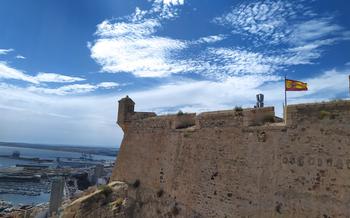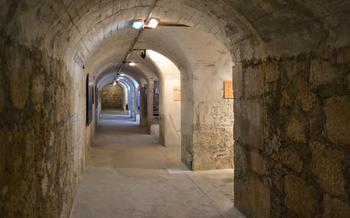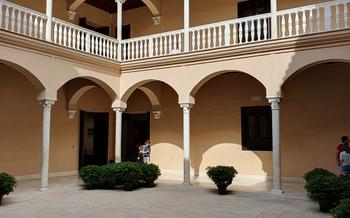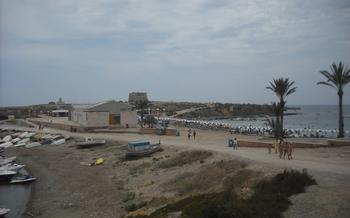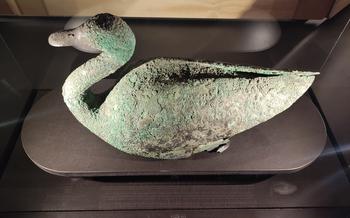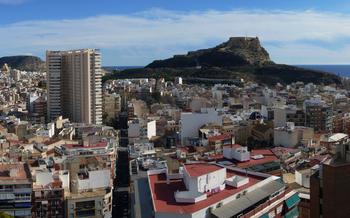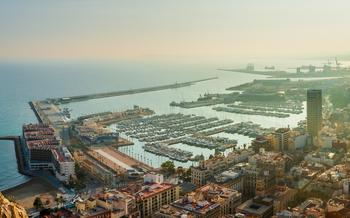
The Museum of the City of Alicante (MUSA)
- The Museum of the City of Alicante (MUSA): A Journey Through Alicante's Past
- Location and Getting There
- Hours of Operation and Admission Fees
- Historical Significance of Alicante
- Collections and Exhibits: Delving into Alicante's Rich History and Cultural Heritage
- Highlights of the Museum
- Museum Architecture and Design
- Educational Programs and Workshops
- Museum Shop and Bookstore
- Accessibility for Visitors with Disabilities
- Food and Dining Options
- Special Events and Exhibitions
- Photography and Social Media
- Insider Tip: Hidden Gems of the Museum
The Museum of the City of Alicante (MUSA): A Journey Through Alicante's Past
The Museum of the City of Alicante (MUSA) is a cultural gem that invites visitors to embark on a captivating journey through the rich history of this vibrant city. Housed in a beautifully restored 18th-century palace, MUSA showcases a diverse collection of artifacts, paintings, and sculptures that narrate the story of Alicante's past. From its humble beginnings as an Iberian settlement to its transformation into a modern metropolis, the museum offers a glimpse into the events and people that have shaped Alicante's unique identity.
Collections: MUSA's collection is a treasure trove of historical artifacts that provide a tangible connection to Alicante's past. Visitors can marvel at ancient Iberian pottery, admire the intricate designs of Roman mosaics, and explore the legacy of the Moors through their exquisite ceramics and metalwork. The museum's collection of paintings and sculptures pays homage to renowned Spanish artists, capturing the essence of Alicante's cultural heritage.
Architecture: The museum's architectural beauty is an attraction in itself. The harmonious blend of Baroque and Renaissance elements creates an elegant and inviting space for visitors to immerse themselves in history. The building's grand entrance, adorned with intricate carvings, sets the tone for the captivating journey that awaits within. The interior courtyard, with its serene fountain and lush greenery, offers a tranquil oasis amidst the bustling city.
Exhibitions: MUSA's permanent exhibitions provide a comprehensive overview of Alicante's history, while temporary exhibitions delve into specific themes or periods, offering fresh perspectives and insights. The museum's curators have skillfully arranged the exhibits to create a dynamic and engaging experience, where visitors can interact with artifacts, watch audiovisual presentations, and learn through interactive displays.
Location and Getting There
The Museum of the City of Alicante (MUSA) is strategically located in the heart of the city, making it easily accessible by various means of transportation. Its exact address is Calle San Fernando, 10, 03002 Alicante, Spain.
Public Transportation:
For those opting for public transportation, MUSA is well-connected by bus lines. Several bus stops are situated within walking distance of the museum, providing convenient access from different parts of the city.
Parking:
For those arriving by private vehicle, there are several parking options available in the vicinity of the museum. Visitors can choose from on-street parking, which is subject to availability, or utilize nearby parking garages that offer secure and convenient parking spaces.
Accessibility:
MUSA is committed to ensuring accessibility for visitors with disabilities. The museum features wheelchair-accessible entrances, ramps, and elevators, allowing visitors to navigate the museum's spaces with ease. Additionally, the museum provides accessible restrooms and designated parking spaces for visitors with disabilities.
Hours of Operation and Admission Fees
The Museum of the City of Alicante (MUSA) welcomes visitors during specific hours of operation. It is open from Tuesday to Saturday, with slightly varying hours on weekdays and weekends. On weekdays, the museum opens its doors from 10:00 AM to 2:00 PM and from 4:00 PM to 8:00 PM, allowing ample time for exploration. On Saturdays, however, the museum operates from 10:00 AM to 2:00 PM, providing a slightly shorter window for visitors.
Admission fees to the museum vary depending on the visitor category. Adults can purchase a standard ticket for 3 euros, while children between the ages of 6 and 12 enjoy a reduced fee of 1 euro. Seniors over the age of 65 and students with valid identification are also eligible for the reduced rate. The museum offers free admission to children under the age of 6, ensuring accessibility for families with young children.
To enhance the visitor experience, MUSA offers guided tours for groups of 10 or more people. These tours provide a deeper dive into Alicante's rich history and are available in various languages upon request. Guided tours come with an additional charge of 2 euros per person, offering an immersive and informative experience for those seeking a more comprehensive understanding of the city's past.
Historical Significance of Alicante
Alicante's rich history dates back to the Iberian civilization, leaving behind remnants of their settlements and culture. The arrival of the Romans brought significant developments, transforming the city into a thriving port and leaving behind archaeological treasures. During the Moorish reign, Alicante flourished under the rule of the Taifa kingdom, with the construction of the iconic Santa Barbara Castle standing as a testament to their legacy. The city underwent a modern transformation in the 20th century, playing a crucial role during the Spanish Civil War. Through these diverse influences, Alicante has emerged as a city brimming with historical significance, offering visitors a glimpse into its captivating past.
Collections and Exhibits: Delving into Alicante's Rich History and Cultural Heritage
The Museum of the City of Alicante boasts an impressive collection of artifacts, paintings, sculptures, and historical documents that narrate the city's rich history and cultural heritage. Archaeological findings from the Iberian, Roman, and Moorish periods provide a glimpse into Alicante's ancient past. Visitors can admire a vast collection of ceramics, tools, jewelry, and other artifacts that showcase the daily lives and customs of Alicante's ancestors.
The museum also houses a notable collection of fine art, featuring paintings, sculptures, and engravings by renowned Spanish artists. These works of art depict scenes from Alicante's history, its people, and its landscapes. Visitors can admire the intricate details and vibrant colors of these artistic creations, which offer a unique perspective on the city's cultural heritage.
In addition, the museum's collection includes a wealth of historical documents, manuscripts, and maps that shed light on Alicante's political, social, and economic development. These documents provide valuable insights into the city's past events, its interactions with other regions, and its role in shaping the history of Spain.
To enhance the visitor experience, the museum incorporates interactive displays that bring history to life. Touchscreens, multimedia presentations, and hands-on exhibits allow visitors to engage with the museum's collection in a dynamic and interactive way. These displays make learning about Alicante's history fun and accessible for visitors of all ages.
Highlights of the Museum
Among the many captivating exhibits at the Museum of the City of Alicante (MUSA), several highlights stand out. The Lucentum Room takes visitors on a journey to the ancient Roman city of Lucentum, showcasing artifacts that provide a glimpse into the daily lives of its inhabitants. The Medieval Room transports visitors back in time with its collection of artifacts and exhibits that shed light on Alicante's medieval period, including the reign of the Moors and the construction of the iconic Santa Barbara Castle.
In contrast, the Modern Room delves into the events and developments that shaped Alicante in the modern era, including its role in the Spanish Civil War and its transformation into a modern, cosmopolitan city. Finally, the museum's temporary exhibitions offer fresh perspectives on Alicante's history, showcasing a diverse range of themes and topics that change regularly. These rotating exhibits keep the museum's offerings dynamic and ensure that there is always something new to discover for visitors.
Museum Architecture and Design
The Museum of the City of Alicante (MUSA) is housed in a historic building that has undergone renovations and expansions to enhance its facilities. The museum's architecture blends traditional and modern elements, creating a harmonious and inviting space for visitors.
The original building, dating back to the 18th century, showcases a classic architectural style with intricate details and ornate facades. Over the years, the museum has undergone several renovations and expansions to accommodate its growing collection and provide a more modern and accessible experience for visitors.
The museum's design incorporates sustainable elements, such as energy-efficient lighting and climate control systems, demonstrating its commitment to environmental responsibility. Accessibility features, such as wheelchair ramps, elevators, and Braille signage, ensure that visitors with disabilities can fully enjoy the museum's offerings.
The museum's architecture and design not only provide a visually appealing backdrop for the exhibits but also contribute to the overall visitor experience, making it an ideal destination for history buffs, art enthusiasts, and anyone interested in exploring Alicante's rich cultural heritage.
Educational Programs and Workshops
The Museum of the City of Alicante (MUSA) recognizes the importance of education and offers a range of programs and workshops tailored to engage visitors of all ages. School groups can embark on guided tours and participate in interactive workshops that bring Alicante's history to life. The museum also hosts family-friendly workshops and activities, providing an opportunity for parents and children to learn and create together. Adults interested in delving deeper into Alicante's past can enroll in workshops and courses designed specifically for them. Furthermore, the museum's research facilities and resources are open to scholars and researchers seeking to further their knowledge of the city's rich history.
Museum Shop and Bookstore
The Museum of the City of Alicante (MUSA) houses a well-stocked museum shop that offers a range of souvenirs, books, and merchandise related to the city's rich history and culture. Visitors can browse and purchase unique souvenirs, such as replicas of ancient artifacts, postcards featuring iconic landmarks, and traditional handicrafts made by local artisans. The shop also stocks a selection of history-themed gifts, such as books on Alicante's history, art prints, and decorative items inspired by the city's heritage. By supporting the museum shop, visitors not only take home a piece of Alicante's history but also contribute to the local economy and the preservation of the city's cultural heritage.
Accessibility for Visitors with Disabilities
The Museum of the City of Alicante (MUSA) is committed to providing an accessible and inclusive environment for all visitors, regardless of their abilities. Wheelchair users can navigate the museum's galleries and exhibits with ease, thanks to designated wheelchair-accessible routes and ramps. Braille signage is strategically placed throughout the museum to assist visually impaired visitors in finding their way around. Additionally, audio guides are available for visitors with hearing impairments, ensuring that everyone can enjoy the museum's rich collection. The museum also offers sensory experiences and exhibits that cater to visitors with various disabilities, creating a truly inclusive and welcoming space for all.
Food and Dining Options
For a quick bite or a refreshing break, the museum's on-site café offers a variety of refreshments, snacks, and light meals. Visitors can enjoy a cup of coffee, tea, or juice, accompanied by pastries, sandwiches, or salads. The café provides a comfortable and convenient space to relax and recharge before continuing their exploration of the museum.
For those seeking a more substantial meal, a plethora of restaurants and eateries are located within walking distance of the museum. From traditional Spanish cuisine to international flavors, there's something to satisfy every palate. Visitors can indulge in local specialties such as paella, fideuà, or arroz a banda, or opt for international dishes ranging from Italian pasta to Asian noodles.
For those who prefer a leisurely picnic, designated areas within the museum grounds provide a serene setting to enjoy a packed lunch or snacks. Visitors can spread out a blanket and savor their meal while surrounded by the museum's lush greenery and tranquil ambiance.
Special Events and Exhibitions
The Museum of the City of Alicante (MUSA) is not just a repository of historical artifacts; it's also a vibrant cultural hub that hosts an array of special events, exhibitions, and programs throughout the year. Temporary exhibitions, often in collaboration with other institutions or artists, bring fresh perspectives and insights into Alicante's history and culture. These exhibitions showcase diverse themes, from ancient civilizations to contemporary art, offering visitors new experiences with each visit.
Cultural events, workshops, and lectures are regularly organized to engage and educate the public. Renowned historians, archaeologists, and experts share their knowledge and insights on various aspects of Alicante's past, providing visitors with a deeper understanding of the city's rich heritage. These events foster a sense of community and create a platform for cultural exchange and dialogue.
Museum Nights, held periodically, offer a unique opportunity to experience the museum after hours. With extended opening hours, special guided tours, live music, and themed activities, these evenings provide a different perspective on the museum's collection and history. Seasonal celebrations, such as Christmas markets or summer festivals, add a festive touch to the museum's offerings, creating a vibrant and lively atmosphere.
Photography and Social Media
The Museum of the City of Alicante encourages visitors to capture and share their experiences through photography. While respecting the museum's guidelines, visitors are free to take photos of the exhibits and the museum's interior, except for areas where photography is restricted. To enhance the museum's online presence and foster a sense of community, visitors are encouraged to share their photos on social media using the designated hashtags. The museum also offers virtual tours and online exhibitions for those who cannot visit in person. Additionally, several picturesque spots within the museum, such as the grand staircase or the rooftop terrace, provide excellent opportunities for capturing memorable photos that can be shared with friends and family.
Insider Tip: Hidden Gems of the Museum
Beyond the main exhibits, the Museum of the City of Alicante (MUSA) holds a few hidden gems that are worth exploring. One such gem is the secret room, a hidden chamber that houses rare and unique artifacts that are not on display in the main galleries. Visitors can inquire about access to this secret room, which offers a glimpse into the museum's lesser-known treasures.
Another hidden gem is the rooftop terrace, which offers stunning panoramic views of Alicante's cityscape and the surrounding mountains. Visitors can enjoy breathtaking views of the city's landmarks, including the Santa Barbara Castle and the Mediterranean Sea.
For those interested in delving deeper into Alicante's history, the museum's archives offer a wealth of information and resources. Researchers and scholars can access a vast collection of documents, manuscripts, and photographs that provide insights into the city's past.
Finally, visitors can inquire about docent-led tours, which offer a more personalized and in-depth experience of the museum's collection. Docents are knowledgeable experts who can provide fascinating insights and anecdotes about Alicante's history and culture.
